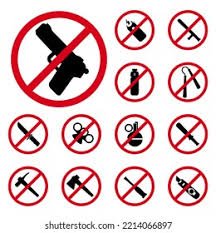SOP for Handling and Control for Prohibited Items .

Standard Operating Procedure (SOP)
1. Purpose
The purpose of this SOP is to provide guidelines for the identification, handling, storage, and disposal of prohibited items within [Organization/Department Name], ensuring compliance with all relevant legal, regulatory, and organizational policies.
2. Scope
This SOP applies to all employees, contractors, and personnel responsible for managing prohibited items within [Organization/Department Name]. It covers procedures for handling prohibited items such as illegal substances, restricted chemicals, weapons, and other regulated items.
3. Definitions
-
Prohibited Items: Items or substances that are banned, regulated, or restricted by laws, regulations, or organizational policies. This includes controlled substances, hazardous materials, weapons, and other dangerous items.
-
Controlled Substances: Substances regulated by governmental authorities due to their potential for abuse, danger, or misuse (e.g., narcotics, certain chemicals).
-
Restricted Items: Items that, due to their nature, require special handling or storage (e.g., radioactive materials, firearms, or sensitive documents).
4. Responsibilities
-
All Personnel: Must be aware of and follow this SOP when encountering or handling prohibited items.
-
Security Personnel: Responsible for monitoring and securing prohibited items, ensuring they are kept in controlled access areas.
-
Supervisors/Managers: Ensure that staff are trained on the procedures for handling prohibited items and verify that this SOP is followed.
-
Compliance Officer: Ensure adherence to legal and regulatory requirements concerning prohibited items, including audits and inspections.
-
Legal and Regulatory Affairs Department: Provide guidance on the legal handling, storage, and disposal of prohibited items.
5. Materials and Equipment
-
Secure storage areas (e.g., locked cabinets, safes)
-
Personal Protective Equipment (PPE) as required
-
Surveillance cameras (if applicable)
-
Incident reporting forms
-
Authorized disposal containers
-
Logbooks or inventory management system
6. Procedure
6.1 Identification of Prohibited Items
-
Pre-Receipt Identification:
-
Prohibited items must be identified before receipt or acceptance, based on the organization’s policy or relevant legal regulations (e.g., controlled substances, banned chemicals).
-
Any items suspected to be prohibited must be flagged by the receiving personnel.
-
-
Upon Receipt or Discovery:
-
Verify whether an item is prohibited based on documentation, certification (e.g., Certificate of Analysis), and internal guidelines.
-
If an item is suspected to be prohibited, immediately notify the supervisor and security personnel.
-
Record the item’s details (e.g., name, description, quantity, serial number) in the prohibited items log.
-
6.2 Handling of Prohibited Items
-
Access Control:
-
Only authorized personnel should handle prohibited items.
-
Secure access to prohibited items by storing them in locked, monitored areas with restricted access.
-
-
Notification:
-
Notify relevant authorities or legal teams immediately upon discovery or receipt of prohibited items (e.g., local law enforcement, regulatory authorities).
-
Document all actions taken in handling the prohibited items.
-
-
Safe Handling Procedures:
-
Use appropriate PPE (e.g., gloves, safety glasses, lab coat) when handling prohibited items, especially hazardous or toxic substances.
-
Follow safety data sheets (SDS) for any chemicals or hazardous materials.
-
Avoid direct contact with prohibited items, and use tools or equipment (e.g., tongs, tweezers) to handle them when possible.
-
-
Storage Requirements:
-
Prohibited items must be stored in designated, secure, and controlled areas.
-
Ensure that containers are appropriately labeled and the items are protected from unauthorized access, theft, or environmental damage.
-
6.3 Documentation and Record-Keeping
-
Logbook Maintenance:
-
Maintain a logbook for all prohibited items, including details such as:
-
Name and description of the item
-
Date received or discovered
-
Lot number or serial number (if applicable)
-
Storage location
-
Actions taken (e.g., notification to authorities, disposal instructions)
-
Final disposition (e.g., return to supplier, disposal, or destruction)
-
-
-
Incident Reports:
-
Complete an incident report for any event involving the handling or discovery of prohibited items. This includes:
-
The time and date of the event
-
Names of individuals involved
-
Description of the prohibited item and actions taken
-
Any follow-up actions required.
-
-
-
Inventory Management:
-
Track and maintain a real-time inventory of prohibited items, ensuring that unauthorized access is prevented.
-
Update records regularly, particularly after actions such as handling, inspection, or disposal.
-
6.4 Disposal of Prohibited Items
-
Disposal Procedures:
-
Prohibited items that cannot be returned to suppliers must be disposed of according to local regulations.
-
For hazardous or controlled substances, disposal should be carried out by a licensed disposal company or in collaboration with regulatory bodies (e.g., hazardous waste management services).
-
-
Documentation of Disposal:
-
Ensure that the disposal process is fully documented, including the method of disposal, the date, and the responsible personnel or third-party service.
-
Maintain records of disposal in the prohibited items logbook.
-
6.5 Periodic Audits and Inspections
-
Regular Audits:
-
Conduct routine audits of prohibited items to ensure compliance with this SOP and relevant regulations.
-
Audits should check the accuracy of the logbooks, the condition of the items, and compliance with storage requirements.
-
-
Inspection of Storage Areas:
-
Perform periodic inspections of areas where prohibited items are stored to verify security and ensure that items are handled according to the proper protocols.
-
7. Precautions
-
Ensure Proper Labeling: Always ensure prohibited items are clearly labeled with appropriate warnings and handling instructions.
-
Security Measures: Implement security measures (e.g., surveillance cameras, alarm systems) to protect prohibited items from theft or unauthorized access.
-
Follow Legal and Regulatory Requirements: Ensure all actions are compliant with applicable laws and regulations regarding the handling, storage, and disposal of prohibited items.
🎓 Discover one of the best Quality Assurance courses available — click below to explore the course that’s shaping future QA skills.

